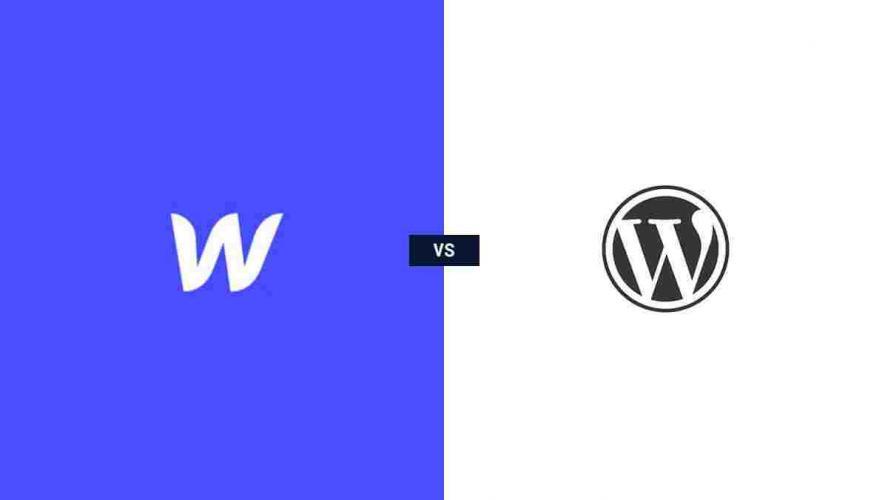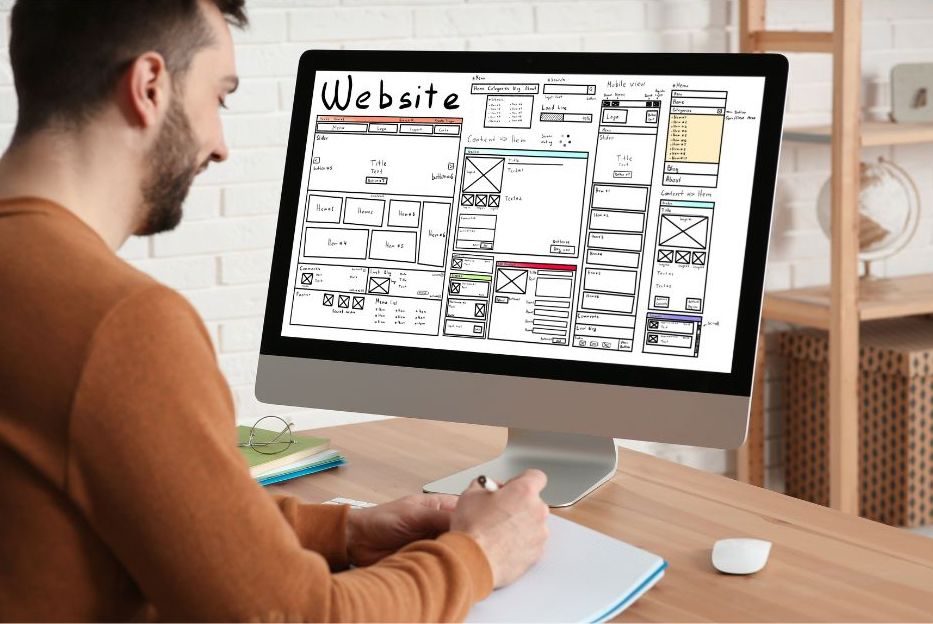It all starts with a CMS you can rely on. Content management systems like WordPress.com or Squarespace are designed to give you everything you need to manage and improve your website in no time. With the right CMS, you can create everything from an exciting blog to a range of product pages, and you don't even need to know much about HTML or CSS.
If you've been looking for the best platform for building your website for a long time, then WordPress is probably the solution you've heard about the most. After all, 34% of all sites in the world are built with WordPress.
However, if WordPress is popular, that doesn't mean it’s the only option.
In this Webflow vs WordPress post, we're going to introduce you to a new solution that might be perfect for your business.
Introduction
Let's start simple.
Both WordPress and Webflow are website builders designed to make your online experience easier.
WordPress is the most popular open-source and PHP content management system on the market. It offers the simplicity of a fully flexible back end and tons of website design customization options. You can build your WordPress site however you want using tons of plugins for things like SEO, checkout processes, and more.
On the other hand, Webflow is a popular cloud-based SaaS platform. The range of comprehensive tools that this system offers makes it almost as reliable as a CRM as it is WordPress. Featuring Webflow, you can access a fantastic canvas to build your website. However, you may need a few freelance developers to help you get the most out of technology.
Let's take a closer look at what you can do with each option.
Pricing
Before we start exploring the web design features that you can access from both Webflow and WordPress, it's important to make sure your content management system fits your budget. Remember that there are many options for building websites, starting with Wix in Drupal, and they all come at different prices.
Webflow comes with two types of service plans to choose from. First option site plans that start at $ 12 per month are for those who just want a site without a CMS. However, if you want to use the CMS functionality to improve your rankings on Google and other search engines, you need to upgrade to $ 16 per month.
The CMS plan includes support for 100,000 2000 visitors per month, 3 CMS items, a content editor, and more. There's also a more advanced Business plan for $ 36 per month that comes with even more functionality, including a CMS API.
If you prefer ecommerce plans, you can start with the standard plan at $ 29 per month. It comes with all the features of the CMS suite, but you can also spend up to $ 50K on sales and create up to 3 employee accounts. This plan includes a 2% transaction fee and Webflow branding, however.
Upgrade to the Plus plan and you can get rid of that pesky branding and fees, but you'll pay $ 74 per year. In addition, the advanced plan is available for $ 212 per year, which gives you unlimited annual sales and 15 employee accounts. ...
Webflow pricing can be much more complex than WordPress. While you can access things like Webflow hosting and a free SSL certificate to keep things simple, it's tricky at first to know which package you need. There is no free plan, but you can start with a trial.
Alternatively, WordPress is a completely free and open-source solution. However, you have to deal with a lot of the additional costs yourself. For example, you won't have a support team unless you create one yourself. You should also check out your own WordPress hosting options, invest in things like CDN technology, and even get help developing a website.
The ultimate cost of building a WordPress site can be expensive. However, it all depends on you. The good thing about WordPress web development is that small businesses have complete control over how much they want to spend.
Ease of use
Building the perfect website takes a lot of time and experimentation.
The best CMS is usually something flexible, customizable, and relatively easy to use.
One nice thing about Webflow is that it is completely branded, which means professional developers and designers can use it to create a white label. The software comes with a huge amount of expertise that allows you to dive deeper into things like JavaScript code.
At first glance, you can already see that the editor is much more advanced than most of the drag and drop options you get from other website builders.
If you plan to work on multiple projects at the same time, Webflow allows you to easily switch between them using tabs. Plus, you can integrate with things like Adobe Photoshop to make your Webflow site look as attractive as possible.
Webflow also comes with its own ecommerce engine that allows users to develop incredibly responsive websites that go beyond the functionality of things like Weebly. However, the deep functionality of Webflow also means that it requires significant training. Unlike other tools, it will take you a while to understand how this whole system works. The upside is that once you get used to Webflow, you can do a lot with it, including creating parallax effects, animations, and more.
WordPress takes a different approach to helping companies build their websites. In the WordPress vs Webflow debate, it's worth remembering that WordPress started life as a blogging platform. This comes with additional complications such as being forced to find your own hosting services. Plus, unlike Shopify, where you don't have to learn a line of code, you'll need some basic coding knowledge to build your WordPress site.
The good news is that WordPress in general is much easier to use than Webflow. It comes with an extensive community of experts to help you get started, and there are tons of opportunities to improve your site's performance with things like WordPress plugins.
In terms of features and functionality, neither WordPress nor Webflow is specifically designed for beginners. However, many developers are likely to prefer Webflow because it has a number of integrated elements built into it. On the other hand, with WordPress, you really need to create pretty much everything from scratch.
While Webflow seems familiar to professional designers and developers, especially if they are working with things like Adobe Photoshop or Muse, WordPress can seem more complex. On the other hand, open source WordPress makes it a great choice for anyone looking to customize their templates and codes using HTML / PHP ideas and plugins.
Design tools
Take a look at any Webflow custom website builder review and you will see that this ecommerce website builder is one of the most flexible out there. Webflow gives you complete control over everything from JavaScript to HTML. What's more, a visual page builder means you can follow the interface of your design.
A drag-and-drop interface means you can start from a blank page and quickly navigate to the perfect site. You can also view your website's page structure in the navigator and restructure elements one click at a time.
Every element on your Webflow site pages will also be responsive, so you don't have to worry about getting everything to work with your design tool for every device. You can focus on providing great uptime for your customers, whether you are building an e-commerce website or blog.
Webflow also allows you to create custom interactions and animations throughout your site. The great thing about this functionality is that the builder allows you to create these visuals without using a line of code.
From scroll-based animations to unique elements that relate to scrolling progress, there is something for every kind of website. You can also enable things like the show on click, which makes your pages more engaging and dynamic when a customer interacts with them.
Alternatively, designing a website with WordPress is a slightly different experience. You usually start with a theme from a free or premium provider and build from there. This means you are not using a blank canvas - although you have many customization options. You can also pay for a professional to make the theme for you.
After installing your chosen theme, you can customize everything from fonts to images and sizes. Moreover, you can use plugins to add additional functionality that is not included in the existing theme.
Developers also have full access to WordPress code if you want to jump right into the tricky parts of creating a WordPress website. However, it is really recommended to take this route if you have enough experience.
Content management
When you're building an incredible online presence, it's important not only to build the foundations of your website. You also need something to help you deliver incredible content to the world.
The good news is that Webflow has a CMS that caters to everyone from developers and designers to content management, you can create your content right on the page and watch your site evolve as you go. In addition, it is possible to add additional options such as displaying content using filters.
If you want to add search functionality to your website, you can do that too. No need to worry about complicated control panels. Editing your content right on the page makes it much easier to understand how things will work on your interface.
What's more, because Webflow integrates with Zapier, you can integrate it with many other tools to make your site and content more engaging.
On the other hand, since WordPress was originally built as a blogging tool, it makes sense to make it much easier to add content to your site.
The WordPress backend is simple and straightforward. You don't need to know any code for basic publishing, and you can manage it all from your WordPress dashboard, which is intuitive and easy to use.
WordPress gives you the ability to add as many pages to your site as you choose, so you can create anything from a simple site that only spans a couple of pages to a complex site with hundreds of different page variations. Building a beautiful and well-functioning website is easy with WordPress. What's more, adding other authors and users to the mix is easy too.
WordPress.org comes with a set of multi-user capabilities, including various access rights and unique components to help you grow your business. If you're looking for a CMS system that really makes it easy to get started publishing content online, WordPress is by far the best choice.
Ecommerce Opportunities
There is, of course, a good chance that you will want to do a lot more than just publish blogs on your site. If you want to make money, you can also list products for your customers. Luckily, both WordPress and Webflow can help with this.
If you are an ecommerce business, Webflow can make it easier for you to sell products and scale your business to suit your needs. Divi dual needs. Every page you create is completely customizable, from product page to checkout. Plus, unlike other website builders, checkout pages can match the rest of your website exactly.
You can even set up transactional emails that you send to your customers to confirm purchases. This makes it much easier to ensure that every aspect of your messages and image remains the focus.
On top of that, customers will have the option to pay for their products as they see fit, which is always a huge bonus. All consumers choose to buy from brands that give them complete freedom to shop. In Webflow, the dashboard integrates with everything from Apple Pay to Google Pay, Stripe and PayPal.The Order Dashboard is very easy to use as well, and you can print shipping labels with ease as well.
Of course, just because Webflow is easy to use for ecommerce doesn't mean that WordPress doesn't have its advantages either. All you have to do to get started here is install a free solution like the WooCommerce plugin. The WooCommerce plugin is very popular and easy to use.
Aside from a minimal learning curve for beginners, WooCommerce is highly customizable, which means heaven is the limit to what you can do with your online store. What's more, there are hundreds of free and paid extensions that you can add to WooCommerce too.
You can implement whatever you need to fulfill your shipping and fulfillment requirements, and even create your own dropshipping deal with WooCommerce too!
Customer Support
Once you've fully explored the full potential of tools like WordPress and Webflow, and you've considered your needs when it comes to budgeting, it's important to think about how much help you're going to get.
One nice thing about Webflow is that it comes with a huge knowledge base maintained by Webflow University. Here you can find all the information you need to get started building websites. You can also access everything from integration requirements to hosting. There are many video tutorials and users can keep in touch with support via live chat and phone calls.
Ultimately, you have more than enough ways to contact your customer support team using Webflow if you need more help.
The same cannot be said for WordPress, since it is an open source platform like Flexbox, you are pretty much on your own. WordPress doesn't have a customer support team, and you're stuck finding answers to your questions using recommendations from other developers.
On the positive side, WordPress is a very popular CMS, so there is a lot to do. Chances are, you can find at least a handful of blogs and videos to guide you in the right direction. However, it doesn't help much if you need one-on-one support.
Pros and cons of Webflow
WebflowLike any website creation service, it has its pros and cons. For example, you can get the freedom to build a fully custom website with this solution. However, you will also have a relatively high learning curve to deal with.
Pros
- The freedom to create the perfect website
- Drag and drop page builder for a deeper understanding of your page design
- Create interactions and animations without code
- Make changes to your content pages right on the page
- SEO friendly website development
- Invite contributors and editors to work with you
- Powerful hosting support with limited downtime
- Free SSL Certificate
Cons
- Significant learning curve takes time to get used to
- Slightly more expensive than some of the alternatives
- Not all features are available on the e-commerce side yet
Pros and cons of WordPress
Just because WordPress This is the most popular CMS on the market today, this does not mean that it will automatically become the right choice for every business owner. Each company has its own unique requirements for website development. On the one hand, WordPress is free to use, but that also means you have to handle everything from hosting to finding a design yourself.
Pros
- Free to use if you can find your own hosting
- Fully customizable so you can have deep control over your site
- Thousands of themes, plugins and extensions to help make your website unique
- Easy to use if you don't have a lot of programming experience
- Not much of a learning curve for people just starting out
- Great for building SEO optimized websites and blogs
- Fantastic for content creation
- Thousands of integrations already available for WordPress
- Huge community for help and support
Cons
- You will need to hire a developer if you want to go beyond the basics
- You will be responsible for all updates and maintenance on your site.
- No direct customer support
Bottom line: which one to choose?
So, when it comes to building your own website, which option should you choose? As is usually the case when choosing business tools and software, there really isn't a one-size-fits-all solution. Webflow and WordPress are very popular tools that have a lot to offer both newbies and developers or designers. However, they take a completely different approach to the web development process.
While Webflow is a great tool for building ready-to-go websites from scratch - it's best for developers and designers. This unique tool is very advanced dumb and uses sophisticated environments to help you bring your ideas to life. You don't need a lot of programming knowledge to become an expert on Webflow, but it does take time to get used to some pretty deep software. This really isn't a tool that newbies will love.
WordPress, on the other hand, is a highly respected and popular content management system. This solution includes everything from thousands of free templates to themes to help you get started online. It is more suitable for beginners who do not have a lot of development experience. While not as detailed as Webflow, it is a great way to get started on the web. However, you will have to deal with more internal complexity on your own.
Which one should you choose?
It all depends on you. Choose the CMS that suits your website, your business, and your basic knowledge.

Nadejda Milanova
An experienced Content creator in the field of Search Engine Optimization (SEO) and WordPress. A true proffesional with a Master's degree focused on journalism.
Read more by Nadejda Milanova





